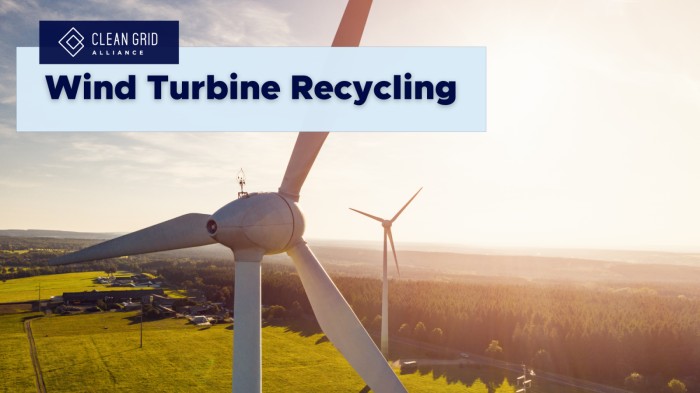Wind Turbine Recycling and Disposal
 | Alex Thompson, Communications Associate |

 | Alex Thompson, Communications Associate |
Wind turbines provide 9.8% of the United States' electricity. Over the past 40 years, the wind industry has grown into the largest source of renewable electricity generation in the United States, powering millions of American homes and businesses every day. In eight states, wind energy is responsible for over a quarter of the electricity produced, while Iowa leads the nation with over 60% of the electricity generated in the state coming from wind turbines. As the industry matures, older, less efficient turbines are being replaced with better technology.
The need for a recycling process is growing, and new innovations are arising that could help the industry reach its goals. Currently, up to 94 percent of a wind turbine's parts can be recycled. This includes the foundation, tower, gear box and generator. However, the rotor blades are made of composite materials, mostly consisting of fiberglass and carbon fiber, that are particularly difficult to recycle.
What does the process of recycling a wind turbine look like? There are a few different options available today. Below is a non-exhaustive list of some of the options available.
Mechanical Recycling
Mechanical recycling entails cutting and dismantling blades. The parts are shredded into raw fiberglass material that produces fine and course particulates that can be mixed with rock, plastic or other fillers. The mixture is then turned into thermoplastic fiberglass pellets or panels for use in various products. These pellets can also be used in injection molding and extrusion manufacturing processes, decking boards, warehouse pallets, parking bollards, manhole covers, building walkways and weather-resistant siding. REGEN Fiber is a recycling company that uses a mechanical process to break down turbine blades. The company has a facility in Fairfax, Iowa capable of recycling 30,000 tons of wind turbine blades per year.
Cement Co-Processing
Cement co-processing is currently the most cost-effective, scalable, and commercially viable recycling option. Cement co-processing involves mechanical shredding of the blade and feeding the shredded pieces into a cement kiln. The resin and core components of the blade provide energy for the chemical reaction, reducing the quantity of coal required for the traditional cement kiln. During the process, thermal recycling saves concrete production 23% of its overall carbon dioxide emissions and 13% of its water consumption.
There are occasions when a wind turbine blade is unable to be recycled. However, even if landfilled, turbine blades represent a tiny portion of the waste going into U.S. landfills. The Electric Power Research Institute (EPRI) reported that all turbine blade waste through 2050 represents approximately 0.05% of all the municipal solid waste going to landfills every year. Unlike other energy source waste, wind turbine blades are made from non-toxic fiberglass and are completely landfill-safe. Plus, new innovations are on the horizon that could help the industry reach its goal of 100% sustainability.
Toward a Circular Economy
In August of this year, researchers from the National Renewable Energy Laboratory (NREL) released a study that shows an alternative, easily recyclable material can replace the composites that pose the biggest challenge in the recycling process. The new material is derived from biomass (i.e. "plant stuff") and can be broken down through mild chemical processes that save both time and materials. The best part is it is on par with current industry standards for blade durability. While the new technology is still in its infancy, it's a promising idea. Time will tell if it can be scaled into the wind industry in a meaningful way.
As innovative recycling methods continue to develop, they move the wind industry closer to a circular economy where materials, products, and services stay in circulation for as long as possible. It saves time and money, simultaneously improving business conditions and restoring our planet.